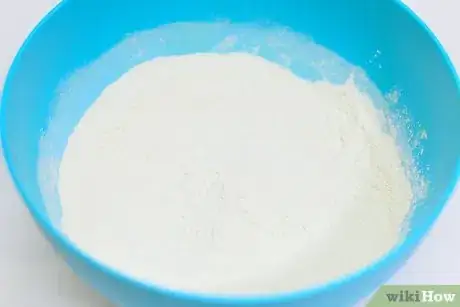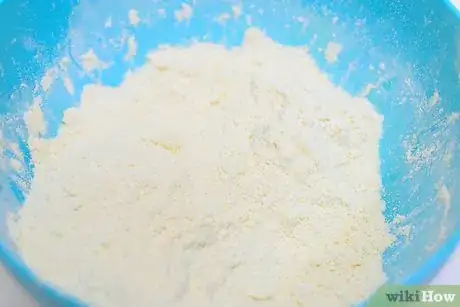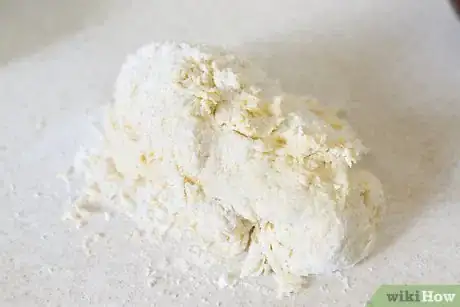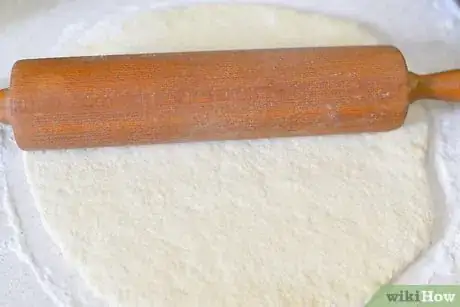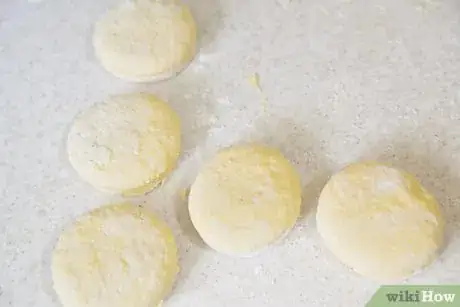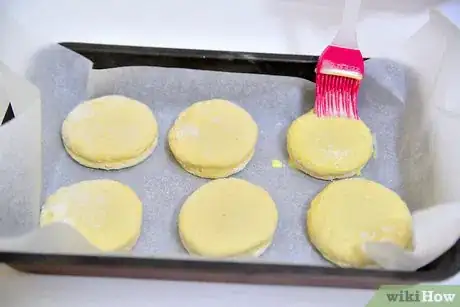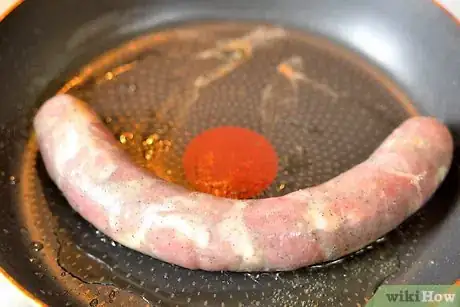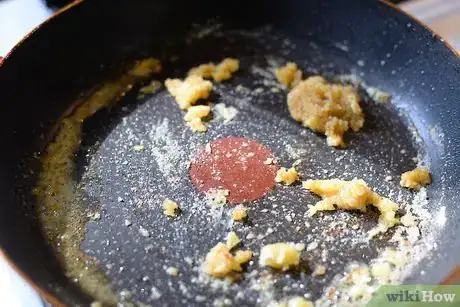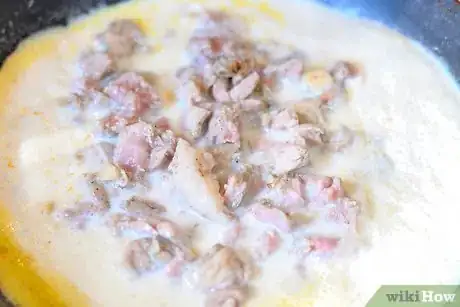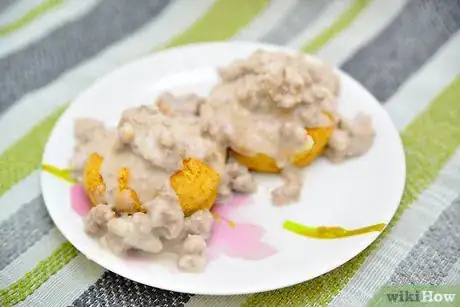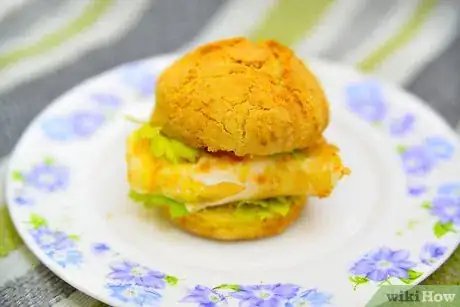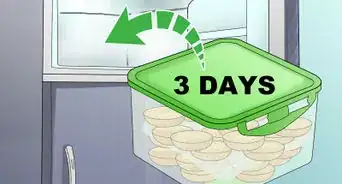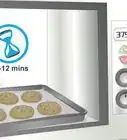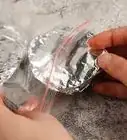This article was co-authored by wikiHow Staff. Our trained team of editors and researchers validate articles for accuracy and comprehensiveness. wikiHow's Content Management Team carefully monitors the work from our editorial staff to ensure that each article is backed by trusted research and meets our high quality standards.
There are 8 references cited in this article, which can be found at the bottom of the page.
This article has been viewed 106,910 times.
Learn more...
Hardee's is a fast food restaurant known for their home-style buttermilk biscuits. The biscuits are available plain, with blueberry topping, slathered in gravy, and cut in half to make sandwiches. You can make Hardee's biscuits at home with a few basic ingredients, and can turn them into delicious breakfast sandwiches for a morning treat or late-night snack.
Ingredients
Makes 12 biscuits
- ¼ cup (56 g) sugar
- 5 cups (625 g) self-rising flour
- 1 teaspoon (4 g) baking powder
- 1 cup (205 g) vegetable shortening
- 2 cups (474 ml) buttermilk, chilled
- ½ cup (119 ml) water, chilled
- Salted butter, for brushing
- 12 ounces (340 g) sausage
- 2½ cups (293 ml) whole milk
- ¼ cup (31 g) flour
- 3 tablespoons (43 g) butter
- Salt, to taste
- Pepper, to taste
Steps
Baking Hardees Biscuits at Home
-
1Preheat your oven and melt the butter. Turn your oven on to 450 F (232 C) and let it preheat while you prepare the biscuits.[1] Place about 2 tablespoons (30 g) of butter into a glass bowl. Place the bowl on top of the oven so the butter will warm and melt over the heat from the oven.
- Use a glass or metal bowl for the butter, as this will conduct heat better and allow the butter to melt. Also, a plastic bowl might melt from the heat of the oven.
- Melt the butter in the microwave or in a pot on the stove if your oven top doesn't get hot enough to melt it.
-
2Sift together the dry ingredients. Position a large sifter over a large mixing bowl. Measure the sugar, self-rising flour, and baking powder, and pour them into the large sifter. Tap the side of the sifter with your hand to sift the dry ingredients into the bowl. This will remove lumps and help incorporate the three ingredients.
- To make your own self-rising flour, combine 5 cups (625 g) of all-purpose flour, 7½ teaspoons (30 g) of baking powder, and 1¼ teaspoons (7.5 g) of salt.[2]
Advertisement -
3Rub in the shortening. Add the shortening to the bowl with the dry ingredients. With your fingers, rub the shortening into the flour. Continue mixing the ingredients together in this way until the dough takes on the texture of large crumbs.[3]
- For a richer and flakier biscuit, you can use lard instead of vegetable shortening.
-
4Add the buttermilk and water. With your hand, make a well in the center of the dough. Pour the cold buttermilk and water into the well. Use a wooden spoon or rubber spatula to combine the wet and dry ingredients. Stop as soon as the dough starts to come together.
- The biscuit dough will be sticky, but resist the urge to keep stirring. Overmixing will develop the gluten and make for dense and chewy biscuits.[4]
-
5Fold the dough. Turn the dough out onto a floured countertop or flat surface. Sprinkle some flour on top of the dough. Flatten the dough into a circle with your hands. Fold the left side of the dough into the center, and then the right side of the dough on top of that. Starting from the top, roll the dough into a pinwheel and shape it into a ball.
- Flatten out the dough with your hands and repeat these same folding steps a second time.[5]
- Folding the dough in this way will fully incorporate all the ingredients without overmixing the dough.
- Avoid kneading, which can also develop the gluten.
-
6Roll the dough. Roll the dough out with the rolling pin. Continue rolling until you have a one-inch (2.5-cm) thick circle. Make sure the dough is an even thickness, otherwise your biscuits will be different sizes.
- Add more flour to the rolling pin and counter to prevent sticking.
-
7Cut the dough. Use a floured 2-inch (5-cm) round cookie cutter to punch out as many biscuits as possible.[6] When you can't get any more biscuits, collect the dough scraps. Shape them into a ball and roll out the leftover dough. Cut out as many biscuits as you can.
- Repeat until there's no longer enough dough for more biscuits.
-
8Brush the tops with butter. Transfer the biscuits to the baking sheet. Position them side by side so they're all just touching. Take your pastry brush and brush the tops of the biscuits with the melted butter that's been warming on the oven.[7]
- Brushing the tops with butter will add a bit of a salty kick to the biscuits, and help them become a nice golden brown when they bake.
-
9Bake the biscuits. Transfer the biscuits to the oven and bake them for 10 to 15 minutes. The biscuits are ready when they turn a light golden brown color. When they're done, remove them from the oven.
- Set the baking sheet aside and let the biscuits cool for a few minutes.
-
10Cool the biscuits before serving. When the biscuits are cool enough to handle, transfer them to a wire cooling rack. Set them aside until they're cool enough to eat, about 30 minutes.
- Serve the biscuits plain, buttered, with jam or cream, or with cheese, meat, gravy, or any other topping you like.
Making Biscuits and Sausage Gravy
-
1Cook the sausage. Place a large frying pan over low heat and preheat the pan for about five minutes. Place the sausages in the pan and cook them over low heat. Use tongs to turn the sausages every two minutes. Cook the sausages for about 12 minutes, or until no pink remains and they're starting to brown.
- When the sausages are done, remove the pan from the heat.
-
2Remove the cooked sausages from the pan. With the tongs, take the sausages out of the pan and transfer them to a plate. Set them aside to cool. Leave the grease from the meat in the pan and return the pan to the stove.[8]
- It's important to use tongs instead of a fork to cook and move the sausages. A fork will pierce the meat and release the juices, making for drier sausage.
-
3Cook the flour in the butter and sausage grease. Add the butter to the frying pan with the sausage grease and heat it over medium heat. When the butter has melted, add the flour to the pan and whisk to combine it with the fat.
- Cook the flour for about five minutes, whisking regularly, until it becomes smooth and golden brown.[9]
-
4Add milk and simmer. When the flour is smooth and golden, pour the milk into the pan, whisking as you pour to prevent lumps. Bring the gravy to a low boil, and then reduce the heat to medium-low. Continue simmering for 10 to 12 minutes, until the gravy thickens.[10]
- Add milk by the tablespoon (15 ml) to the pan if the gravy becomes too thick, or until the desired consistency is achieved.
-
5Crumble in the sausage and season the gravy. Use your fingers to break up each sausage into small chunks. Sprinkle the sausage pieces into the gravy and stir to combine. Taste the gravy and add salt and pepper if necessary.[11]
- Once the sausages have warmed, remove the pan from the heat.
-
6Ladle the gravy over fresh biscuits and serve. Place one or two warm biscuits on a serving plate. Spoon or ladle about a ¼ cup (59 ml) of hot gravy over each biscuit and enjoy![12]
- Avoid pouring the gravy on the biscuits until you're ready to serve them, as the gravy can make the biscuits soggy.
Recreating Hardee's Biscuit Sandwiches
-
1Have a meat sandwich. Biscuits can be cut in half, stuffed with various ingredients, and served like sandwiches. These are a popular item on the Hardee's breakfast menu. A couple of the popular biscuit sandwiches are the plain meat ones, which are served with:
- A chicken filet
- A smoked sausage
- A few slices of country ham
-
2Make an egg sandwich. Another popular breakfast sandwich is the egg, meat, and cheese combination. This usually consists of the biscuit with a layer of meat, followed by a cooked egg and topped with cheese. You can use a variety of meats for this sandwich, including:
- Bacon
- Steak or chicken fried steak
- Sausage
-
3Make a monster breakfast sandwich. A monster sandwich at Hardee's consists of fresh biscuits, ham, cheese, sausage, egg, and bacon. To assemble the sandwich:
- Cut the biscuit in half
- Place one to two slices of ham on the bottom half of the bun
- Place a slice of cheese on top of the ham
- Place a cooked sausage patty on top of the cheese, followed by another piece of cheese
- Place a cooked egg on top of the cheese, followed by two to three pieces of bacon
- Top the sandwich with the top of the biscuit and enjoy
Community Q&A
-
QuestionMy biscuits spread out and flatten. What am I doing wrong?
 Community AnswerPlace the biscuits in the pan so they touch one another. This should cause them to rise rather than spread.
Community AnswerPlace the biscuits in the pan so they touch one another. This should cause them to rise rather than spread. -
QuestionThese are good, but definitely do not taste like, nor do they have the flaky texture of Hardees biscuits.
 Ann HupeCommunity AnswerThe taste can be very dependent on what ingredients are in the self-rising flour and how old it is. Personally, I would make biscuits using King Arthur's self-rising flour. This flour is milled like the old Southern-style biscuit (the best biscuit in the world), using a soft winter wheat. You may have used the more commonly found hard red wheat, and there is a HUGE difference.
Ann HupeCommunity AnswerThe taste can be very dependent on what ingredients are in the self-rising flour and how old it is. Personally, I would make biscuits using King Arthur's self-rising flour. This flour is milled like the old Southern-style biscuit (the best biscuit in the world), using a soft winter wheat. You may have used the more commonly found hard red wheat, and there is a HUGE difference.
Things You'll Need
Biscuits
- Small bowl
- Large mixing bowl
- Sifter
- Wooden spoon
- Rolling pin
- 2-inch (5-cm) round cookie cutter
- Baking sheet
- Pastry brush
- Wire cooling rack
Gravy
- Large frying pan
- Tongs
- Plate
- Whisk
- Ladle or spoon
References
- ↑ http://www.food.com/recipe/hardees-biscuits-443621
- ↑ https://www.thekitchn.com/how-to-make-self-rising-flour-232729
- ↑ http://www.foodnetwork.com/recipes/alton-brown/southern-biscuits-recipe.html
- ↑ http://www.realsimple.com/food-recipes/cooking-tips-techniques/basic-cooking/overmixing-doughs-batters
- ↑ https://www.youtube.com/watch?v=YooNgvDT53E
- ↑ http://www.foodnetwork.com/recipes/alton-brown/southern-biscuits-recipe.html
- ↑ http://www.cooks.com/recipe/at12p9lm/hardees-biscuits.html
- ↑ http://www.grouprecipes.com/124749/sausage-gravy-southern-style.html
- ↑ http://www.grouprecipes.com/124749/sausage-gravy-southern-style.html

